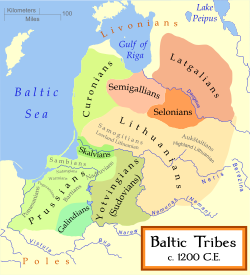Skalvians
This article needs additional citations for verification. (December 2021) |

The Scalovians (Lithuanian: Skalviai; German: Schalauer), also known as the Skalvians, Schalwen and Schalmen, were a Baltic tribe related to the Prussians. According to the Chronicon terrae Prussiae of Peter of Dusburg, the now extinct Scalovians inhabited the land of Scalovia south of the Curonians and Samogitians, by the lower Neman River ca. 1240.
Geography
[edit]This region is located at both sides of the river Memel north of Nadruvians and south of Samogitia. In the North-East it stretched to rivers Šešupė, Ežeruona and Jūra.[citation needed] In the East it bordered on Sudovia, in the North-West on river Minija, in the West on the Curonian Lagoon and in the South-West on river Gilija.[1] [citation needed] The center were the towns of Rusnė, Ragainė and Tilžė.[citation needed]
Name
[edit]The meaning is uncertain: skalwa "splinter (living split off)" or skalauti "between waters". According to Prussian legends, the tribe's name is derived from one of the sons of King Widewuto named Schalauo.
History
[edit]An editor has launched a copyright investigation involving this section. The text under investigation is currently hidden from public view, but is accessible in the page history. Please do not remove this notice or restore blanked content until the issue is resolved by an administrator, copyright clerk, or volunteer response agent.
The purported copyright violation copies text from https://www.vle.lt/straipsnis/skalviai/ ; as such, this page has been listed on the copyright problems page. Unless the copyright status of the text of this page or section is clarified and determined to be compatible with Wikipedia's content license, the problematic text and revisions or the entire page may be deleted one week after the time of its listing (i.e. after 22:46, 22 October 2025 (UTC)). What can I do to resolve the issue?
Steps to list an article at Wikipedia:Copyright problems:
|
Language
[edit]| Skalvian | |
|---|---|
| Scalovian | |
| Region | Lithuania and Kaliningrad |
| Ethnicity | Skalvians |
| Era | 13th century[citation needed] |
Indo-European
| |
| Language codes | |
| ISO 639-3 | svx |
svx | |
| Glottolog | None |
 Former extent of West Baltic languages, including Skalvian.
Sudovian †
Skalvian †
| |
Skalvian, or Scalovian, is the presumed West Baltic language or dialect of the Skalvians.[3] It could also haven been a transitional language between Eastern and Western Baltic languages.[4]: 16
Literature
[edit]- Balys, Jonas: Grundzüge der Kleinlitauischen Volksdichtung, in Tolkemita-Texte “Lieder aus Schalauen” Nr.53, Dieburg 1997
- Eckert, Rainer/ Bukevičiute, Elvire-Julia/ Hinze, Friedhelm: Die baltischen Sprachen, eine Einführung, Langenscheidt 1994, 5. Auflage 1998
- Lepa, Gerhard (Hrsg): Die Schalauer, Die Stämme der Prußen, Tolkemita-Texte 52, Dieburg 1997
- Matulaitis, K.A.: Die Schalauer des Altertums, Tauto praeitis II, 2, 1965, in Tolkemita Texte, Dieburg 1997
- Salemke, Gerhard: Lagepläne der Wallburganlagen von der ehemaligen Provinz Ostpreußen, Gütersloh, 2005
- Salys, Anatanas: Schalauen, Lietuviu Enciklopedija, 1962, Boston, Band 27, S. 536–541, aus dem Litauischen in Tolkemita-Texte 52, Dieburg 1997
- Salys, Anton: Die zemaitischen Mundarten, Teil 1: Geschichte des zemaitischen Sprachgebiets Tauta ir Zodis, Bd-VI Kaunas 1930 (= Diss. Leipzig 1930)
- Tettau, v.: Volkssagen Ostpreußens, Litthauens und Westpreußens, Berlin 1837, S.10
- Trautmann, Reinhold: Über die sprachliche Stellung der Schalwen. Streitberg Festgabe Leipzig 1924, S.355 ff
References
[edit]- ^ Waldman, Carl; Mason, Catherine (2006). Encyclopedia of European Peoples. Infobase Publishing. ISBN 978-1-4381-2918-1.
- ^ "skalviai". vle.lt.
- ^ Zinkevičius, Zigmas (1996). The History of the Lithuanian Language. Translated by Plioplys, Ramutė. Vilnius: Mokslo ir enciklopedijų leidykla. p. 51. ISBN 9785420013632.
- ^ Rinkevičius, Vytautas (2015). Prūsistikos pagrindai [Fundamentals of Prussian linguistics] (in Lithuanian). Vilnius: Vilniaus universitetas. ISBN 978-609-417-101-7.

